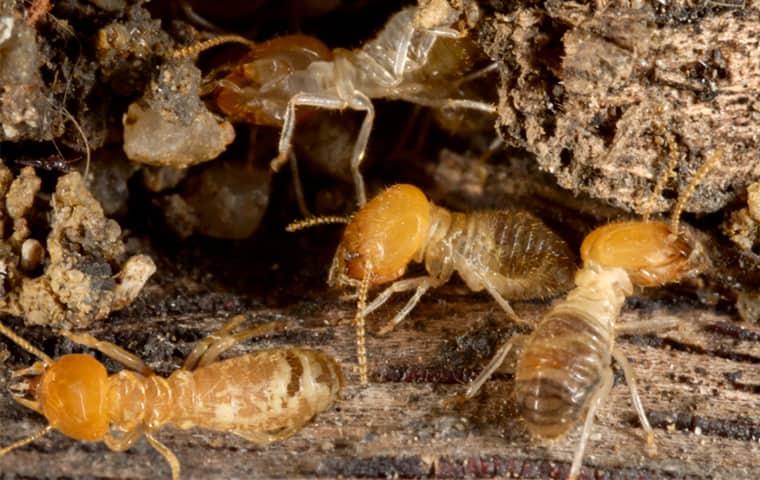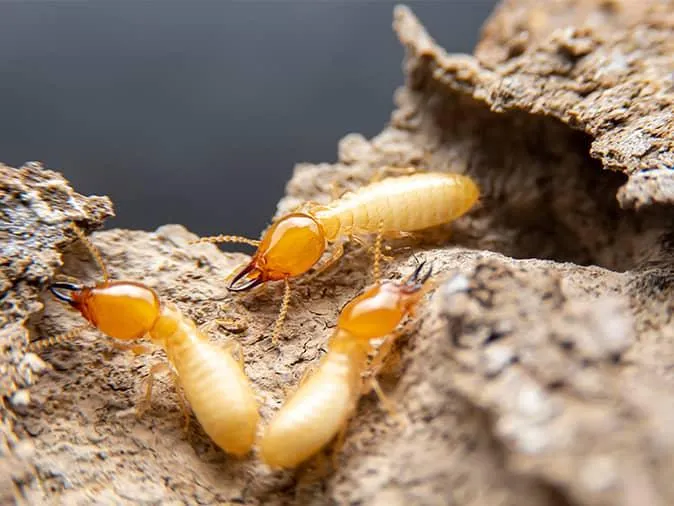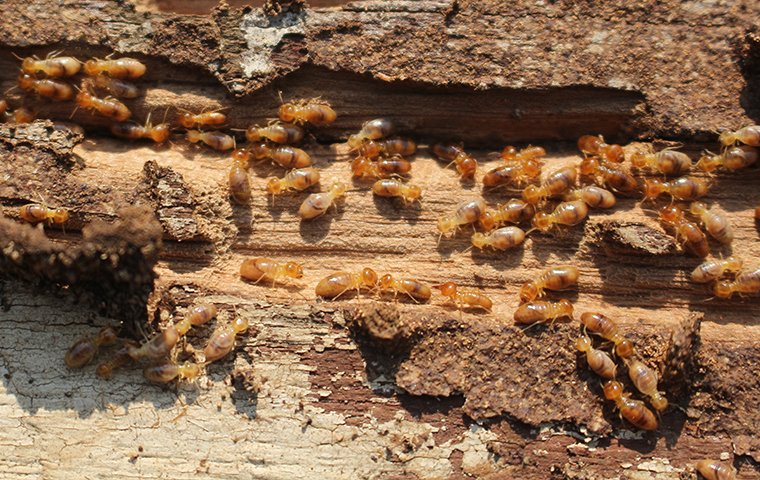No, termites cannot make you sick. They directly do not transmit diseases or pathogens to humans, and their presence primarily concerns property damage rather than health risks.
However, some health risks are still associated with termites, and that’s what I’ll discover for you. So, Here you begin!
Health Risks Associated with Termite
Termites are notorious for causing structural damage to homes, but can these tiny insects also put your health at risk? In this section, I’ll explore the health risks associated with termites, both directly and indirectly.
Section A: Direct Health Risks
Allergies and Respiratory Issues: Termites can release tiny particles and allergens into the air when they infest your home.
Breathing in these particles can trigger allergies and respiratory problems, especially in individuals who are already sensitive to allergens. If you have asthma or allergies, termite infestations may exacerbate your symptoms.
Bites and Stings: While termites are not known for biting or stinging humans like some other pests, they can still cause skin irritation and allergic reactions in rare cases. Handling or disturbing termites may lead to skin rashes or itching for some individuals.
Section B: Indirect Health Risks
Mold and Fungal Growth: Termites create moist environments within the Wood they infest, promoting mold and fungi growth.
Breathing in mold spores from the air can cause respiratory issues, including allergies and other health problems. Mold can also damage your home’s indoor air quality.
Structural Damage Leading to Accidents: Although not a direct health risk, the structural damage caused by termites can indirectly endanger your well-being.
Weakened wood structures may collapse or break, posing a risk of accidents and injuries to the occupants of the affected building. Falling ceilings, floors, or walls can cause serious harm.
Conclusion: While termites may not directly make you sick in the same way as some other pests, they can still pose significant health risks.
You shouldn’t underestimate the Allergies, respiratory issues, and the potential for accidents resulting from structural damage from termites.
Allergies and Respiratory Issues

A. Explaining Termite-Related Allergies
Exposure to substances produced by termites triggers termite-related allergies. These tiny insects can release particles and allergens into the air when they infest your home. These allergens can be problematic, especially for those with sensitivities.
B. Symptoms and Signs of Termite Allergies
Itchy Eyes and Nose: A common symptom is having itchy, watery eyes and a runny or blocked nose.
Skin Rashes: Some individuals may develop skin rashes or hives after contact with termites or their secretions.
Coughing and Sneezing: Allergies can lead to persistent coughing and sneezing.
Wheezing and Shortness of Breath: In severe cases, asthma-like symptoms may occur, such as wheezing and shortness of breath.
C. Who is Most at Risk for Termite-Related Allergies?
While anyone can develop allergies to termites, certain groups are more susceptible:
Asthma or Allergy Sufferers: Individuals with pre-existing asthma or allergies are at higher risk.
Children and the Elderly: Their immune systems may be more sensitive.
Frequent Termite Exposure: People who work in termite-infested areas or homes may be more prone to developing allergies.
D. Preventative Measures and Treatment Options
Protecting yourself from termite-related allergies involves taking preventive steps:
Pest Control: Regular termite inspections and professional pest control can prevent infestations.
Seal Entry Points: Close gaps and crevices to keep termites out.
Ventilation: Good ventilation can help reduce indoor allergen levels.
Allergy Medications: You can use over-the-counter or prescription allergy medications to improve symptoms.
Consult an Allergist: If you suspect termite allergies, consult an allergist for testing and personalized treatment.
Conclusion: Termites may not make everyone sick, but termite-related allergies can be a genuine concern for some. Understanding the symptoms, risks, and preventive measures is crucial.
Bites and Stings of Termite
A. The Likelihood of Termite Bites and Stings
Generally, termites are not known for biting or stinging humans like bees or mosquitoes. Their primary focus is on consuming wood and cellulose materials. The likelihood of experiencing termite bites or stings is extremely low.
B. Identifying Termite Bites and Stings
Identifying termite bites or stings can be challenging, given their rarity. However, if you do encounter such a situation, you might notice:
Localized Irritation: Redness, itching, or mild swelling in the affected area.
Possible Allergic Reactions: In sporadic cases, individuals may experience an allergic response to termite bites or stings.
C. How to Treat Termite Bites and Stings
If you suspect a termite bite or sting, follow these simple steps:
Clean the Area: Clean the termite-affected area with soap and water to avoid infection.
Apply a Cold Compress: Use a cold compress or ice pack to reduce swelling and ease discomfort.
Over-the-counter Medications: Antihistamines or anti-itch creams can help alleviate itching and irritation.
D. Tips for Avoiding Termite Encounters
While termite bites or stings are rare, it’s still a good idea to take precautions to avoid encounters with these insects:
Regular Inspections: Schedule regular termite inspections to detect and prevent infestations.
Seal Entry Points: Seal cracks, gaps, and openings in your home to keep termites out.
Keep Wood Away: Avoid stacking Wood near your home’s foundation, as this can attract termites.
Conclusion: In most cases, termites are not a direct threat in terms of bites or stings. While they focus on Wood, not humans, it’s still important to take preventive measures to keep them away from your home.
Mold and Fungal Growth
You might not think termites can make you sick, but you should know
the hidden danger of mold and fungal growth.
A. How Termites Contribute to Mold and Fungal Growth
Termites can inadvertently create conditions that encourage mold and fungi to thrive:
Moisture Buildup: Termites need moisture to survive, and their activities can lead to damp conditions in the Wood they infest.
Wood Damage: As termites chew through Wood, they create tunnels and pockets where moisture collects, creating an ideal environment for mold and fungi.
Wood Decay: Termite-infested Wood begins to break down, providing a food source for mold and fungi.
B. Health Risks Associated with Mold and Fungi
Exposure to mold and fungi can pose health risks, including:
Respiratory Problems: Inhaling mold spores can trigger or worsen respiratory conditions like asthma or allergies.
Allergic Reactions: Mold allergies can lead to symptoms such as sneezing, coughing, and skin rashes.
Infections: Some molds produce mycotoxins, which can be harmful when ingested or come into contact with wounds.
C. Preventing Termite Infestations to Reduce Mold Risks
Preventing termite infestations is key to lowering the risk of mold and fungal growth:
Regular Inspections: Conduct regular termite inspections to catch infestations early.
Timely Treatment: If termites are found, seek professional pest control to eliminate them.
Repair Damaged Wood: Replace or repair termite-damaged Wood promptly to prevent moisture buildup.
Enhance Ventilation: Proper ventilation helps reduce indoor humidity levels.
Manage Moisture: Address water leaks and maintain good drainage to prevent excess moisture around your home.
While termites may not make you sick directly, they can indirectly contribute to health problems by fostering mold and fungal growth.
Structural Damage and Accidents Caused by Termites

While termites might not make you sick in the traditional sense, they pose a subtler threat: structural damage that can lead to accidents.
In this section, you’ll discover how termite infestations affect building structures, the safety hazards they create, and how to safeguard your home’s structural integrity.
A. Impact of Termite Infestations on Building Structures
Termites can wreak havoc on building structures in the following ways:
Wood Weakening: Termites feed on Wood, weakening its structural integrity over time.
Tunnel Formation: They create tunnels and passages within the Wood, further compromising its strength.
Support Damage: Critical support beams and wooden elements can become targets, jeopardizing the stability of the building.
B. Potential Safety Hazards Due to Weakened Structures
The consequences of termite-induced structural damage can lead to safety hazards:
Collapses: Weakened ceilings, floors, or walls can collapse, causing injuries to occupants.
Tripping Hazards: Sagging floors or stairs can create tripping hazards.
Risk of Entrapment: Falling debris from a weakened structure can pose risks of entrapment or injury.
C. Ensuring the Structural Integrity of Your Home
To safeguard your home from structural damage caused by termites, take these precautions:
Regular Inspections: Schedule routine termite inspections to catch infestations early.
Professional Pest Control: Seek professional pest control services to eliminate termites if an infestation is detected.
Prompt Repairs: Repair or replace termite-damaged Wood promptly to prevent further deterioration.
Reinforcement: Consider reinforcing vulnerable areas with termite-resistant materials.
Maintain Foundations: Ensure your home’s foundation remains stable by addressing termite activity in the vicinity.
Although termites might not make you sick in the traditional sense, the structural damage they can cause poses significant safety risks.
Some relevant Questions on Termites
Can termites bite humans and make them sick?
Termites can bite humans, but their bites are not known to transmit diseases or cause sickness.
Do termites carry pathogens that can infect humans?
Termites do not carry pathogens or diseases that can infect humans, unlike some other pests.
Can termite droppings (frass) make you ill if inhaled or touched?
Inhaling or touching termite droppings is not harmful to humans but does not cause illness.
Do termite infestations pose any health risks to residents?
Termite infestations themselves are not a direct health risk to humans as they do not transmit diseases.
Can exposure to termite pesticides be harmful to human health?
Professionals should apply pesticides used for termite control according to safety guidelines, and when used correctly, they pose minimal health risks to humans.
Are there allergic reactions associated with termite infestations?
Some individuals may develop allergies to termite saliva, feces, or body parts, resulting in mild allergic reactions, but these are not typically severe or illness-inducing.
Can termites damage structures in a way that affects indoor air quality?
Termites can damage wooden structures, but their activities do not directly impact indoor air quality or make residents sick.
Is there any link between termite infestations and respiratory problems?
There is no direct link between termite infestations and respiratory problems in humans.
Can termites contaminate food or water sources in homes?
Termites are not known to contaminate food or water sources in homes, and they do not carry foodborne pathogens.
Conclusion
While termites do not directly cause illness or sickness in humans, there are potential indirect health risks associated with their presence.
Termites are known to damage wooden structures and create tunnels, which can weaken the structural integrity of buildings, potentially leading to accidents or injuries.
Additionally, termite infestations can cause allergies or respiratory issues in sensitive individuals due to the release of airborne particles such as termite droppings and shed body parts.
However, it is important to note that these health risks are relatively uncommon and vary depending on an individual’s sensitivity.

